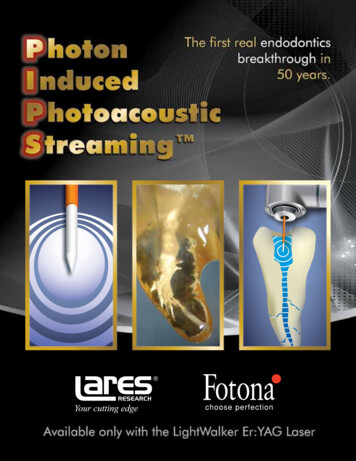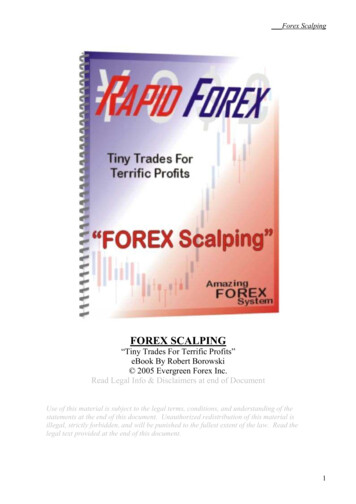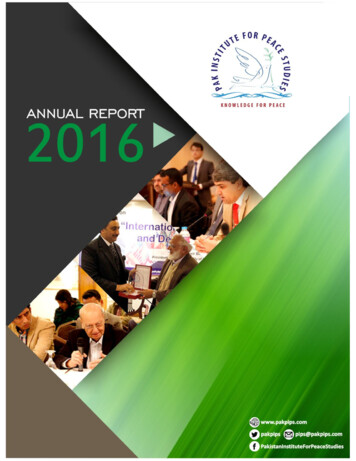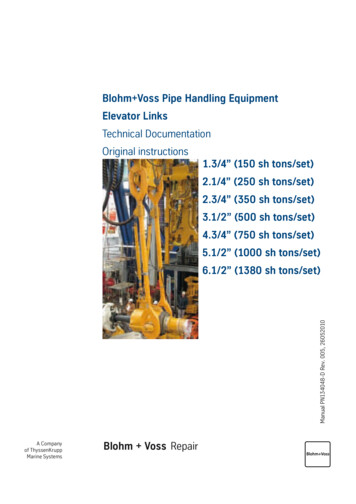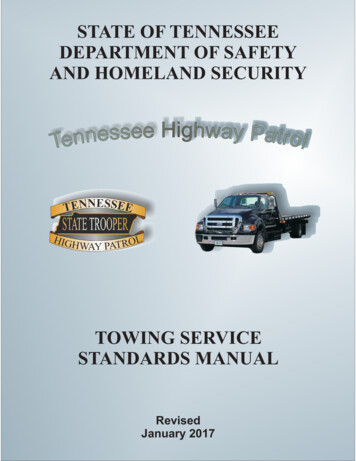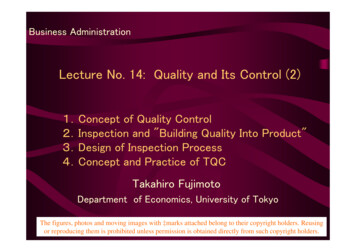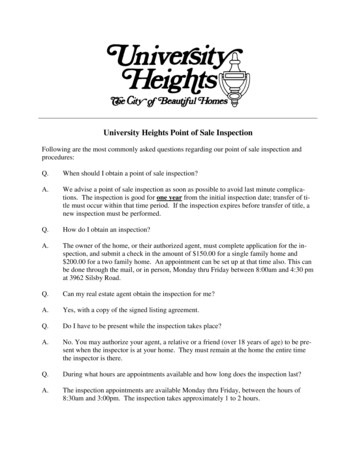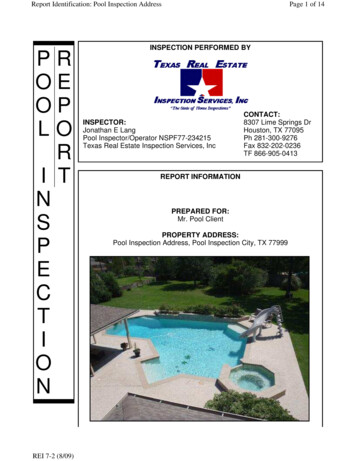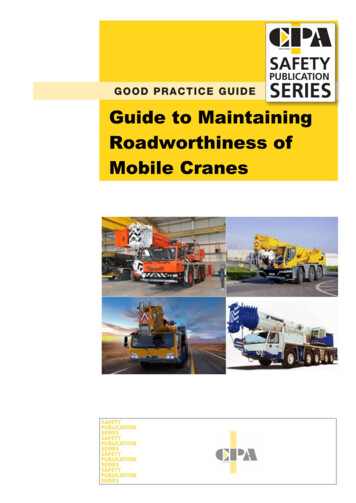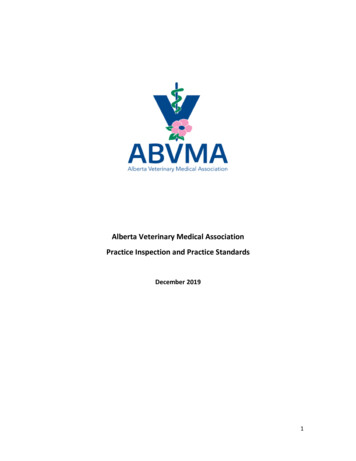
Transcription
Alberta Veterinary Medical AssociationPractice Inspection and Practice StandardsDecember 20191
PRACTICE INSPECTION PRACTICE STANDARDSThese standards are developed to meet the requirements of the Veterinary Profession GeneralRegulation (Part 4) and the Alberta Veterinary Medical Association Bylaws (4.7.5), and replacesall former versions of the Practice Inspection Practice Standards Bylaw.TABLE OF CONTENTSGeneral Definitions .3/4Universal ership . . 5Business Standard and Work Place Safety .8Professional Image & Responsibility 9Disaster/Emergency Preparedness .11Biosecurity & Biomedical Waste Management .12Facility Standard .21Medical Records 24Library .31Pharmaceutical Management .33Service Category 0SC-11SC-12SC-13SC-14SC-15Primary Care 37Ambulatory Care .41Animal Housing .43A. General Housing . .43B. Isolation .45Anesthesia .47Sterile Surgery .53A. In-Facility Surgical Suite . .54B. Farm Animal Surgery .57Companion Animal Dentistry . 59Equine Dentistry . 61Diagnostic Imaging .62Lasers . .66Diagnostic Laboratory .71A. In House (VPE) Diagnostic Laboratory .71B. Referral Diagnostic Laboratory . .72Rehabilitation Therapy . .74Chemotherapy . . .77Embryo Transfer . . .82Mobile Facility . 84Temporary Facility . . .872
Definitions:Companion Animal: an animal kept for companionship and enjoyment.Farm Animal: includes all production animals as well as all equines, regardless of theirpurpose.Informed Consent: the veterinarian has informed the client or the client’s authorizedrepresentative, in a language that is understood by a layperson, of the diagnostic andtreatment options, risk assessment, and prognosis, and has provided the client with anestimate of the charges for veterinary services to be rendered and the client has consentedto the recommended treatment.Minimum Practice Standards: are established by this bylaw and must be met by everyapproved VPE. They are the minimum acceptable elements that constitute an approved VPEindependently, considering its respective practice category/activity.Practice Inspection/Practice Standards Committee (PIPS): this is a legislated committee ofthe ABVMA, established under section 4.7 of the general bylaw. The committee is chargedwith certifying veterinary practice entities as being compliant with the minimum standardsas established by the association.Practice Name: this is the name under which the veterinary practice entity offers services.The name must be compliant with the ABVMA general bylaw on naming (4.8).Production Animal: an animal kept for the production of food, fiber or labour, regardless ofspecies.Registered Veterinarian: a person entitled to engage in the practice of veterinary medicineby virtue of registration in accordance with the Veterinary Profession General Regulation.Registered Veterinary Technologist (RVT): a person entitled to engage in a limited scope ofveterinary practice by virtue of registration in accordance with the Veterinary ProfessionGeneral Regulation.Service Category: these are categories of service to which the specific minimum practicestandards apply. Each veterinary practice entity may choose which service categories theyengage in and which species of animal that service is delivered to. If they participate in aservice, they must maintain compliance with the minimum standards for that service andspecies.Universal Standards: these standards must be met and maintained by every veterinarypractice entity before it can be certified.Veterinary Health Care Worker (VHCW): any person engaged within a Veterinary PracticeEntity, including owners, employees, contract workers, students and volunteers.Veterinary Medical Professionals (VMP): individuals entitled and registered to engage inthe practice of veterinary medicine under the Veterinary Profession Act, specificallyveterinarians and veterinary technologists.Veterinary Practice Entity (VPE): the total of buildings, equipment and supplies, registeredveterinarians, RVTs, support personnel and necessary documents that exist for the purpose3
of supplying veterinary services, regardless of whether or not the operation has a fixedgeographic address and location to which the public attends.WHMIS: Short form of Workplace Hazardous Materials Information System. It is acomprehensive plan for providing information on the safe use of hazardous materials usedin Canadian workplaces. Information is provided by means of product labels, safety datasheets (SDS) and worker education programs.4
Universal Standards (US)These standards must be met and maintained by every veterinary practice entity before it canbe certified and commence offering veterinary services.US-1: LeadershipGuiding Principles:The Veterinary Profession Act defines who can practice veterinary medicine and who canown a veterinary practice. It also requires the ABVMA to set standards of practice and tocertify those operations that meet these standards. The goal is to provide the public withthe assurance they wish and the protection they need in regards to the delivery ofveterinary health care procedures in the province. Provision of professional leadership andclear practice standards through these bylaws are essential in meeting this goal.Definitions:Certificate of Quality Assurance: this document is issued by the committee uponverification, by inspection, of compliance with the minimum standards for a veterinarypractice entity.Quality Assurance Self Verification Guide: is a check list of the required elements of thePIPS Bylaw that must be completed and affirmed by the Veterinary Practice Entity team onan annual basis.Responsible Veterinarian: is the unrestricted registered veterinarian appointed by the VPEowner who has the ultimate authority over the VPE including being appropriately informedwith respect to all aspects of the veterinary practice. The Responsible Veterinarian providesoverall guidance to the operation of the VPE ensuring compliance with the VeterinaryProfession Act, General Regulation, ABVMA Bylaws and all Guidelines, is the overalldecision-maker with respect to the operations of the VPE and has taken responsibility andsigned the PIPS documentation, verifying its accuracy to the ABVMA. The ResponsibleVeterinarian is responsible for all aspects of the practice of veterinary medicine of a permitholder.Professional Responsibility:1. Veterinary medicine must only be practiced by a registered veterinarian orappropriately delegated to a registered veterinary technologist under thesupervision of a registered veterinarian.2.A registered veterinarian must be actively engaged in practice activity every daythat the practice entity operates or offers service.3. All veterinary activity performed within a certified veterinary practice entity must beunder the direction and control of a registered veterinarian whose registration doesnot require supervision.5
4. Every veterinary practice entity must ensure continuity of care for patients andclients by provision of out-of-hours emergency services, either by a designated oncall registered veterinarian or referral to an alternate facility with which adocumented agreement (verbal or written) exists.5. The VPE must engage an unrestricted registered veterinarian to act as “ResponsibleVeterinarian” in regards to the operation of the VPE. This person must be familiarwith the statutory requirements for operating a VPE and insure the implementationof all necessary standards of practice. This role may be filled by an ownerveterinarian or an appropriately appointed delegate if the owner cannot fill theposition. This position does not absolve other veterinarians or veterinarytechnologists of their professional responsibilities or liabilities nor does it assumeresponsibility for the professional conduct of other individuals working in the VPE.Practice Standards:1. A veterinary practice entity must define the scope of their professional activity byservice category and species of animal.2. Veterinary medicine may only be practiced in accordance with the criteriaestablished for the respective VPE and applicable association bylaws in anenvironment certified by the ABVMA under the association bylaw.3. Every veterinary practice entity must maintain on an ongoing basis those standardsdesignated as “Universal Standards” (US).4. Each veterinary practice entity must maintain all the minimum practice standardsincluded within the list of each individual “Service Categories” (SC) that the entityhas elected to deliver.5. Each veterinary practice will be inspected and recertified at a minimum of everythree years (such inspection may take place without prior notice from the ABVMA).6. Each veterinary practice entity is required to complete a Quality Assurance SelfVerification Guide annually, and submit the required documentation to the ABVMAas requested.7. Annual practice inspection program fees and other fees established by the ABVMAFinancial Guidelines must be paid in a timely manner by all veterinary practiceentities.8. The annual ABVMA Certificate of Quality Assurance shall be displayed in a locationvisible to the public.9. The annual ABVMA Certificate of Compliance – Radiation Protection Program isposted in the practice.6
New Practices:1. An application for establishment of a new veterinary practice entity must besubmitted and approved by the ABVMA.2. A veterinary practice entity must demonstrate minimum standards and be inspectedand certified prior to commencing operations. A follow up inspection will take placeonce operations are well underway.Ownership:1. A veterinary practice entity must demonstrate minimum standards defined in thebylaw before the first day of operation.2. The owner must provide the Veterinary Practice Entity with the support andresources necessary for the VPE to comply with its obligations under thesestandards.3. Ownership of the VPE shall be recorded with the ABVMA, including all corporateownership, at all levels.4. Each corporation which is veterinarian owned is required to apply for and maintainregistration as a permit holder demonstrating 51% ownership of the shares by aunrestricted veterinarian in Alberta. A non-veterinarian or corporation that is not apermit holder may not directly own shares of a veterinary practice entity.5. The owner of the Veterinary Practice Entity must monitor and enforce compliancewith the systems, policies and procedures referred to in this standard.6. A change in ownership, relocation, major renovation of a veterinary practice entityor changes in service categories offered must be reported to the ABVMA and willrequire an inspection to ensure ongoing approval of the VPE.7
US-2: Business Standards and Work Place SafetyGuiding Principles:All businesses have a responsibility of care for workers, customers and the general public. TheVPE operates as a business within the Province of Alberta and therefore has minimum legalobligations that must be met. A number of different pieces of federal, provincial andmunicipal legislation apply to business operations, including veterinary businesses. Thisstandard is a guideline to assist VPEs to meet their required legal obligations. While specificlegislation is referenced and some requirements are highlighted in the bylaw, the absence ofa specific reference in this document is not intended to imply that the VPE is in any wayexempt from its application.Implementation of this standard should be guided by the Safety Handbook for AlbertaVeterinary Facilities.Operational Procedures:1. The VPEs acting as employers are obligated to be familiar with and adhere toAlberta’s Employment Standards Code.2. The VPE must act in accordance with the Personal Information Protection Act (PIPA)of the province of Alberta:a. The purpose of this Act is to govern the collection, use and disclosure ofpersonal information by organizations in a manner that recognizes both theright of an individual to have his or her personal information protected andthe need of organizations to collect, use or disclose personal information forpurposes that are reasonable. This act applies to every organization; and inrespect of all personal information, all VPEs must be in compliance with theact.3. The VPE must act in accordance with the Canada Anti-Spam Legislation (CASL).4. The VPE must act in accordance with the federal Workplace Hazardous MaterialsInformation System (WHMIS).5. The VPE must act in accordance with the Government of Alberta OccupationalHealth & Safety Act, Regulations and Code.8
US-3: Professional Image and ResponsibilityGuiding Principles:Veterinary medicine is a provincially regulated, self-governing profession. This privilegecomes with significant commitment to protecting the public interest. Public expectationdemands that we maintain a professional image and deliver our responsibilities at anacceptable level. Our first professional responsibility is to ensure the health and welfare ofthe animals under our control.Members of the ABVMA are also expected to treat colleagues, staff and customers withdignity and respect, and should try to promote and maintain good relations with all of theircolleagues. Members must endeavour to continue enhancement of their skills, andprofessional and personal knowledge in the practice of veterinary medicine. All veterinarymedical professionals and support staff must act in a manner that reflects favourably on theprofession.Definitions:Premises Identification Number (PID): is a unique number assigned by Alberta Agricultureand Forestry to any location where livestock or poultry are grown, kept, assembled ordisposed of. The Animal Health Act requires that all VPEs that engage in any of these activitiesmust have a PID.Facility and Equipment:1. The VPE must have an approved operating name, and must not use any name thathas not been approved.2. The VPE must have a fixed mailing address.3. The VPE must have a listed telephone number.4. If the VPE has a fax number, e-mail address, website or other form ofcommunication directed to the public, this information must be recorded with theABVMA.5. The VPE must have a Premises Identification (PID) issued by the Government ofAlberta if livestock, poultry or equine are presented to the location.6. The VPE must have the following insurances in place:a. Business Liabilityb. Professional Liability and MalpracticeOperational Procedures:1. All veterinarians and veterinary technologists must be registered with the ABVMA.2. The VPE must operate under the guidance of a registered, unrestricted veterinarian,designated as the Responsible Veterinarian.9
3. A registered veterinarian responsible for the delivery of veterinary medical servicesmust be present and on duty during hours of operation when the practice ofveterinary medicine is occurring. Notwithstanding, it may be necessary for theveterinarian to be absent from the facility for periods of time within the day forambulatory services, lunch breaks or other reasons; however, they remainresponsible for veterinary activity during this time.4. The course of treatment and case management of all patients must be determinedby a registered veterinarian, with the informed consent of the owner or responsibleparty.5. Unregistered individuals are not permitted to perform any procedure that isconsidered the practice of veterinary medicine.6. Veterinary medical professionals shall respond to and act upon animal welfare casesthat they become aware of, and are ethically expected to report all cases of willfulanimal abuse to the appropriate authority.7. All personnel working for the VPE must present a neat and clean appearance.8. All employees of the VPE must be aware of and follow the ABVMA MarketingActivity Guideline and all phone listings, websites, social media pages and otherforms of advertising must comply with this Guideline as well as the VeterinaryProfession General Regulation.10
US-4: Safety/Emergency PreparednessGuiding Principles:Each VPE must identify the hazards that have happened or could happen in their area andplan specific responses for each scenario. The plan will be different for each VPE. Thepurpose of an emergency plan is to control and respond to accidents or disasters when theyoccur. Planning for short term and long term interruptions within the VPE is recommendedfor the safety of workers, patients and the public, as well as ensuring ongoing patient care.Each VPE must meet their own regional requirements in addition to following theseguidelines.Facility and Equipment:1. The VPE has a written:a. Fire/emergency response plan.b. Hazardous Chemical Spills Protocol.c. Crime Prevention/Personnel Security Plan.d. Contingency Plan in the event of a disaster or emergency that may close theVPE temporarily for business and action plan to maintain the business in analternate location.2. Instructions for building evacuation and animal handling, in case of fire or otheremergencies, are posted and familiar to staff.3. Emergency phone numbers including fire, hospital, police and poison control centreare posted in a readily accessible location and familiar to staff.4. Plans are in place for temporary holding locations for animals.5. The VPE has a posted floor plan showing:a. Fire extinguishers.b. Control valves (Oxygen, gas, water).c. Dangerous areas (chemical storage, Oxygen storage).d. Escape routes, which are accessible and uncluttered at all times.Recommendations:A functional emergency electrical generator is in place capable of providing backup powerresources when the regular system fails.11
US-5: Infection Prevention & Control, Biosecurity & Biomedical Waste Management StandardGuiding Principles:The reduction of risk, prevention, or control of infections or potentially infectious agentswithin each VPE is important in the delivery of good veterinary care and for the protectionof staff, animals in the facility and the public. Thought must be given to how this will beachieved in each VPE, and what level of biosecurity is appropriate for each VPE. The ABVMABiosecurity in Practice manual, the Canadian Committee on Antibiotic Resistance (CCAR)Infection Prevention and Control Best Practices and the 2018 AAHA Infection Control,Prevention, and Biosecurity Guidelines should guide and inform the implementation of thisstandard for each VPE. Other relevant legislation and references are listed in the appendixat the end of this section.Definitions:Sharps: any material that can puncture, penetrate, tear or cut the skin or mucousmembranes, including needles, lancets, glass slides, scalpels, broken glass etc (contaminated or not)Facility and Equipment:1. Appropriate commercial disinfectant with bactericidal, fungicidal and virucidalcharacteristics is used according to manufacturer’s directions to clean surfaces, withparticular attention paid to proper contact times.2. Facilities and equipment exist so that biomedical waste can be safely handled andstored.3. Refrigerated and/or freezer storage for carcasses and body tissues is provided andreadily available for disposal services for prompt and immediate removal.4. A record of disposal service is maintained.5. The method and date of disposal of an animal is recorded in the medical record.Operational Procedures:1. Each VPE must have a written Infection Control Program accessible to all staff. Auseful template for such a program is listed in the appendix at the end of thissection.2. There is adequate means to dispose of or remove all wastes.3. Additional biosecurity measures (including but not limited to: footbaths, protectiveclothing, boots, etc ) are in place where applicable for: isolation, reverse isolation(isolation procedures for protection of the animals in isolation against introductionof organisms from outside) and quarantine as needed. All such measures aredefined as Standard Operating Procedures.12
Note: The ABVMA Biosecurity in Practice manual and the CCAR Infection Preventionand Control Best Practices are a useful reference for these procedures.4. Waste disposal is conducted according to all applicable municipal, provincial andfederal legislation; see Appendix.5. Biomedical waste shall be safely stored in one of the following:a. In a designated location with access limited to authorized personnel.b. At a waste transfer station used solely for the storage of biomedical waste.c. In adherence to the Public Health Act which states that it shall not create apublic nuisance.6. In the absence of biomedical waste disposal services, sharps and other solidbiomedical waste directed for landfill disposal must be rendered nonpathogenic bychemical or thermal on-site sterilization processes. Acceptance of biomedical wasteat the local municipal Class II landfill requires prior permission by the landfill owner.7. Large solid biomedical waste such as body parts removed at surgery and feti thatare too large to be treated chemically or with heat must be handled according tothe Destruction and Disposal of Dead Animals Regulation of the Animal Health Act.8. Sharps are handled in compliance with the Alberta Occupational Health and SafetyAct and Regulations and the Occupational Health and Safety Code (2009), whichrequires that:a. Sharps containers are located as close as practical to where sharps are used.b. Sharps containers have a clearly marked fill line that is not exceeded (usually atthe ¾ mark).c. Sharps containers are sturdy enough to resist puncture under normal conditionsof use and handling, are closable so material cannot fall out, and are leak proofon the bottom and sides.d. Sharps container must not be reopened or material removed once it is placedinside.e. Used needles must not be re-capped.f.Medically engineered sharps are in use where available, unless it is not clinicallyappropriate in a given circumstance.Legislation:Relevant regulations for disposal of body tissues and carcasses include the following:1. The Disposal of Dead Animals Regulation of the Animal Health Act2. Disposal of Biomedical Waste Acceptable Industry Practices13
3. Canadian Council of Minister for the Environment Guidelines for the Management ofBiomedical Wastes in Canada4. Alberta Occupational Health and Safety Code Part 4 – Chemical Hazards, BiologicalHazards and Harmful Substances5. The off-site transportation of biomedical waste for treatment or disposal must be incompliance with the Transportation of Dangerous Goods RegulationAppendix ITemplate for clinic infection control program:Appendix 1: From CCAR Infection Prevention and Control Best PracticesThis document is provided for veterinary practices to use as a template to develop their ownpractice in-clinic protocol for infection prevention and control. The statements are examples ofbest practices in infection prevention and control. Practices are encouraged to adapt thestatements to be effective and attainable for their situation.Below is a detailed summary of the contents and key messages of the CCAR InfectionPrevention and Control Best Practices document. This summary can be adapted as a VPEspecific infectious disease control program protocol.1. Infection prevention and control strategies are designed to protect patients, owners,veterinary personnel and the community. All veterinary personnel should play anactive role in protecting every person and animal associated with the veterinary clinic.2. Decreasing exposure to microorganisms is the most important aspect of diseasecontrol in most situations.3. Every veterinary clinic, regardless of type or size, should have a formal infection controlprogram, a written infection control manual that describes the program, and aninfection control practitioner (ICP) to coordinate the program.4. Some form of surveillance (either passive or active) should be practiced by all veterinaryfacilities. The keys to passive surveillance are to centralize the available data, andto have a designated ICP who compiles and evaluates the data on a regular basis.5. Routine Practices that are critical to infectious disease prevention and control:a. Hand hygiene, including:i.Handwashingii.Use of alcohol-based hand sanitizersb. Risk reduction strategies, particularly those related to:i.Use of personal protective equipment (PPE)ii.Cleaning and disinfectioniii.Laundryiv.Waste managementc. Risk assessment of animals and personnel with regard to:i.Disease transmission14
ii.Disease susceptibilityd. Educationi.Veterinary personnelii.Animal ownersiii.Public6. Hand hygiene is the single most important way to prevent infections in the healthcaresetting. Intact skin is the first line of defense against bacteria. Hand hygiene of somekind should be performed:a. Before and after contact with a patient (especially before performing invasiveprocedures)b. Before and after contact with items in the patient’s environmentc. After any contact with or any activity involving the body fluids of a patientd. Before putting on and especially after taking off gloves7. Personal protective equipment (PPE) is used to protect veterinary personnel andto reduce the risk of pathogen transmission by clothing to patients, owners, veterinarypersonnel and the public.a. Street clothes should always be covered by protective outerwear, such as alab coat, when working in the clinic.b. Protective outerwear, including scrubs, should not be worn outside the clinic.c. Lab coats and gowns worn when handling patients with potentiallyinfectious diseases should be laundered after each use.d. Gloves should be worn when contact with blood, body fluids, secretions,excretions and mucous membranes is possible, as well as when cleaningenvironmental surfaces and when doing laundry if gross contamination ofitems is present.i.Gloved hands should not be used to touch surfaces that will betouched by people with non- gloved hands.ii.Gloves should be removed promptly after use and hand hygieneperformed immediately.iii.Gloves are NOT a substitute for proper hand hygiene.e. Face protection should be used whenever exposure to splashes or sprays islikely to occur.f. Designated footwear or disposable shoe covers may be required for somepatients with infectious diseases. In veterinary clinics, it is important toprevent the spread of infectious materials present on the floor, as patients andpersonnel often have very close contact with the floor.8. Cleaning involves the removal of visible organic matter with soap or detergent,whereas disinfection involves the application of a chemical or other procedure inorder to kill the remaining microorganisms.a. Cleaning must always be done before a disinfectant is used.b. Gloves should be worn when cleaning and disinfecting, and hands should bewashed after finishing any cleaning activity.c. Selection of a disinfectant for a particular purpose should take into accountthe product’s spectrum of activity, susceptibility to inactivation by organicmatter, potential pathogens in the with soaps and detergents, toxicityfor personnel and animals, contact time required, residual activity,corrosiveness, environmental effects and cost.d. Multi-use equipment must be properly cleaned and disinfected between eachpatient. There are three categories of multi-use equipment used on patients:critical, semi-critical and non-critical.i.Disinfectant solutions in which a set of instruments is routinely keptare often referred to as “cold sterile,” but such instruments are15
rarely, if ever, truly sterile. The main indication for cold(chemical) sterilization is for items that cannot tolerate steamsterilization, such as endoscopes.9. Laundry is also an important component of a complete infectious disease controlprogram.a. Linens used in veterinary clinics should be laundered together usingdetergent, and dried in a hot air dryer to promote killing of microorganisms.i.Laundry from potentially infectious cases should be treatedseparately from other laundry, including use of bleach in the washcycle.ii.Linens contaminated with gross organic material must be precleaned by hand to remove such material prior to laundering.iii.Laundry should not be considered clean until it has also been dried.b. Grossly contaminated clinic clothing (e.g. lab coats, coveralls) should belaundered on-site or sent to a commercial laundry facility that is equippedto handle laundry from medical/veterinary facilities.c. If personal clothing becomes soiled it should be laundered at the clinic to avoidtransfer of disease to animals at home.d. Always place soiled linens directly in a hamper or bag designated for dirtylaundry.e. Clean linens should be transported and stored in a manner that preventscontamination.f. Personnel should wear appropriate personal protective equipment (e.g. gloves,lab coat) when handling soiled linens, and perform hand hygiene when the taskis complete.10. Veterinary clinic waste is a potential source of both zoonotic and non-zoonoticinfectious pathogens. Therefore, it is important to handle all such was
appropriately delegated to a registered veterinary technologist under the supervision of a registered veterinarian. 2. A registered veterinarian must be actively engaged in practice activity every day that the practice entity operates or offers service. 3. All veterinary activity performed within a certified veterinary practice entity must be
